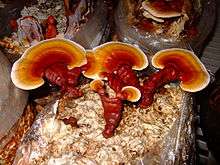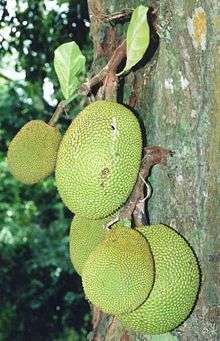Mushroom
A mushroom (or toadstool) is the fleshy, spore-bearing fruiting body of a fungus, typically produced above ground on soil or on its food source.
The standard for the name "mushroom" is the cultivated white button mushroom, Agaricus bisporus; hence the word "mushroom" is most often applied to those fungi (Basidiomycota, Agaricomycetes) that have a stem (stipe), a cap (pileus), and gills (lamellae, sing. lamella) on the underside of the cap. These gills produce microscopic spores that help the fungus spread across the ground or its occupant surface.
"Mushroom" describes a variety of gilled fungi, with or without stems, and the term is used even more generally, to describe both the fleshy fruiting bodies of some Ascomycota and the woody or leathery fruiting bodies of some Basidiomycota, depending upon the context of the word.
Forms deviating from the standard morphology usually have more specific names, such as "bolete", "puffball", "stinkhorn", and "morel", and gilled mushrooms themselves are often called "agarics" in reference to their similarity to Agaricus or their order Agaricales. By extension, the term "mushroom" can also designate the entire fungus when in culture; the thallus (called a mycelium) of species forming the fruiting bodies called mushrooms; or the species itself.
Identification
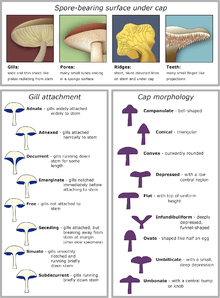
Identifying mushrooms requires a basic understanding of their macroscopic structure. Most are Basidiomycetes and gilled. Their spores, called basidiospores, are produced on the gills and fall in a fine rain of powder from under the caps as a result. At the microscopic level the basidiospores are shot off basidia and then fall between the gills in the dead air space. As a result, for most mushrooms, if the cap is cut off and placed gill-side-down overnight, a powdery impression reflecting the shape of the gills (or pores, or spines, etc.) is formed (when the fruit body is sporulating). The color of the powdery print, called a spore print, is used to help classify mushrooms and can help to identify them. Spore print colors include white (most common), brown, black, purple-brown, pink, yellow, and creamy, but almost never blue, green, or red.[1]
While modern identification of mushrooms is quickly becoming molecular, the standard methods for identification are still used by most and have developed into a fine art harking back to medieval times and the Victorian era, combined with microscopic examination. The presence of juices upon breaking, bruising reactions, odors, tastes, shades of color, habitat, habit, and season are all considered by both amateur and professional mycologists. Tasting and smelling mushrooms carries its own hazards because of poisons and allergens. Chemical tests are also used for some genera.[2]
In general, identification to genus can often be accomplished in the field using a local mushroom guide. Identification to species, however, requires more effort; one must remember that a mushroom develops from a button stage into a mature structure, and only the latter can provide certain characteristics needed for the identification of the species. However, over-mature specimens lose features and cease producing spores. Many novices have mistaken humid water marks on paper for white spore prints, or discolored paper from oozing liquids on lamella edges for colored spored prints.
Classification

Typical mushrooms are the fruit bodies of members of the order Agaricales, whose type genus is Agaricus and type species is the field mushroom, Agaricus campestris. However, in modern molecularly defined classifications, not all members of the order Agaricales produce mushroom fruit bodies, and many other gilled fungi, collectively called mushrooms, occur in other orders of the class Agaricomycetes. For example, chanterelles are in the Cantharellales, false chanterelles such as Gomphus are in the Gomphales, milk-cap mushrooms (Lactarius, Lactifluus) and russulas (Russula), as well as Lentinellus, are in the Russulales, while the tough, leathery genera Lentinus and Panus are among the Polyporales, but Neolentinus is in the Gloeophyllales, and the little pin-mushroom genus, Rickenella, along with similar genera, are in the Hymenochaetales.
Within the main body of mushrooms, in the Agaricales, are common fungi like the common fairy-ring mushroom, shiitake, enoki, oyster mushrooms, fly agarics and other amanitas, magic mushrooms like species of Psilocybe, paddy straw mushrooms, shaggy manes, etc.
An atypical mushroom is the lobster mushroom, which is a deformed, cooked-lobster-colored parasitized fruitbody of a Russula or Lactarius, colored and deformed by the mycoparasitic Ascomycete Hypomyces lactifluorum.[3]
Other mushrooms are not gilled, so the term "mushroom" is loosely used, and giving a full account of their classifications is difficult. Some have pores underneath (and are usually called boletes), others have spines, such as the hedgehog mushroom and other tooth fungi, and so on. "Mushroom" has been used for polypores, puffballs, jelly fungi, coral fungi, bracket fungi, stinkhorns, and cup fungi. Thus, the term is more one of common application to macroscopic fungal fruiting bodies than one having precise taxonomic meaning. Approximately 14,000 species of mushrooms are described.[4]
Etymology

The terms "mushroom" and "toadstool" go back centuries and were never precisely defined, nor was there consensus on application. Between 1400 and 1600 AD, the terms mushrom, mushrum, muscheron, mousheroms, mussheron, or musserouns were used.[6]
The term "mushroom" and its variations may have been derived from the French word mousseron in reference to moss (mousse). However, delineation between edible and poisonous fungi is not clear-cut, so a "mushroom" may be edible, poisonous, or unpalatable.
Cultural or social phobias of mushrooms and fungi may be related. The term "fungophobia" was coined by William Delisle Hay of England, who noted a national superstition or fear of "toadstools".[7][8][9]
The word "toadstool" has apparent analogies in Dutch padde(n)stoel (toad-stool/chair, mushroom) and German Krötenschwamm (toad-fungus, alt. word for panther cap). In German folklore and old fairy tales, toads are often depicted sitting on toadstool mushrooms and catching, with their tongues, the flies that are said to be drawn to the Fliegenpilz, a German name for the toadstool, meaning "flies' mushroom". This is how the mushroom got another of its names, Krötenstuhl (a less-used German name for the mushroom), literally translating to "toad-stool".
Morphology

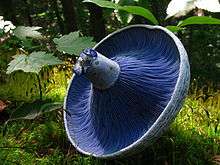
A mushroom develops from a nodule, or pinhead, less than two millimeters in diameter, called a primordium, which is typically found on or near the surface of the substrate. It is formed within the mycelium, the mass of threadlike hyphae that make up the fungus. The primordium enlarges into a roundish structure of interwoven hyphae roughly resembling an egg, called a "button". The button has a cottony roll of mycelium, the universal veil, that surrounds the developing fruit body. As the egg expands, the universal veil ruptures and may remain as a cup, or volva, at the base of the stalk, or as warts or volval patches on the cap. Many mushrooms lack a universal veil, therefore they do not have either a volva or volval patches. Often, a second layer of tissue, the partial veil, covers the bladelike gills that bear spores. As the cap expands, the veil breaks, and remnants of the partial veil may remain as a ring, or annulus, around the middle of the stalk or as fragments hanging from the margin of the cap. The ring may be skirt-like as in some species of Amanita, collar-like as in many species of Lepiota, or merely the faint remnants of a cortina (a partial veil composed of filaments resembling a spiderweb), which is typical of the genus Cortinarius. Mushrooms lacking partial veils do not form an annulus.[10]
The stalk (also called the stipe, or stem) may be central and support the cap in the middle, or it may be off-center and/or lateral, as in species of Pleurotus and Panus. In other mushrooms, a stalk may be absent, as in the polypores that form shelf-like brackets. Puffballs lack a stalk, but may have a supporting base. Other mushrooms, such as truffles, jellies, earthstars, and bird's nests, usually do not have stalks, and a specialized mycological vocabulary exists to describe their parts.
The way the gills attach to the top of the stalk is an important feature of mushroom morphology. Mushrooms in the genera Agaricus, Amanita, Lepiota and Pluteus, among others, have free gills that do not extend to the top of the stalk. Others have decurrent gills that extend down the stalk, as in the genera Omphalotus and Pleurotus. There are a great number of variations between the extremes of free and decurrent, collectively called attached gills. Finer distinctions are often made to distinguish the types of attached gills: adnate gills, which adjoin squarely to the stalk; notched gills, which are notched where they join the top of the stalk; adnexed gills, which curve upward to meet the stalk, and so on. These distinctions between attached gills are sometimes difficult to interpret, since gill attachment may change as the mushroom matures, or with different environmental conditions.[11]
Microscopic features

A hymenium is a layer of microscopic spore-bearing cells that covers the surface of gills. In the nongilled mushrooms, the hymenium lines the inner surfaces of the tubes of boletes and polypores, or covers the teeth of spine fungi and the branches of corals. In the Ascomycota, spores develop within microscopic elongated, sac-like cells called asci, which typically contain eight spores in each ascus. The Discomycetes, which contain the cup, sponge, brain, and some club-like fungi, develop an exposed layer of asci, as on the inner surfaces of cup fungi or within the pits of morels. The Pyrenomycetes, tiny dark-colored fungi that live on a wide range of substrates including soil, dung, leaf litter, and decaying wood, as well as other fungi, produce minute, flask-shaped structures called perithecia, within which the asci develop.[12]
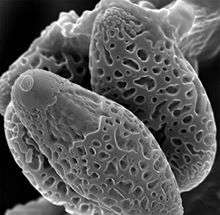
In the Basidiomycetes, usually four spores develop on the tips of thin projections called sterigmata, which extend from club-shaped cells called a basidia. The fertile portion of the Gasteromycetes, called a gleba, may become powdery as in the puffballs or slimy as in the stinkhorns. Interspersed among the asci are threadlike sterile cells called paraphyses. Similar structures called cystidia often occur within the hymenium of the Basidiomycota. Many types of cystidia exist, and assessing their presence, shape, and size is often used to verify the identification of a mushroom.[12]
The most important microscopic feature for identification of mushrooms is the spores. Their color, shape, size, attachment, ornamentation, and reaction to chemical tests often can be the crux of an identification. A spore often has a protrusion at one end, called an apiculus, which is the point of attachment to the basidium, termed the apical germ pore, from which the hypha emerges when the spore germinates.[12]
Growth
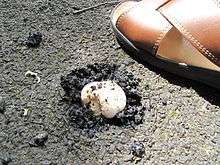
Many species of mushrooms seemingly appear overnight, growing or expanding rapidly. This phenomenon is the source of several common expressions in the English language including "to mushroom" or "mushrooming" (expanding rapidly in size or scope) and "to pop up like a mushroom" (to appear unexpectedly and quickly). In reality all species of mushrooms take several days to form primordial mushroom fruit bodies, though they do expand rapidly by the absorption of fluids.
The cultivated mushroom as well as the common field mushroom initially form a minute fruiting body, referred to as the pin stage because of their small size. Slightly expanded they are called buttons, once again because of the relative size and shape. Once such stages are formed, the mushroom can rapidly pull in water from its mycelium and expand, mainly by inflating preformed cells that took several days to form in the primordia.
Similarly, there are even more ephemeral mushrooms, like Parasola plicatilis (formerly Coprinus plicatlis), that literally appear overnight and may disappear by late afternoon on a hot day after rainfall.[13] The primordia form at ground level in lawns in humid spaces under the thatch and after heavy rainfall or in dewy conditions balloon to full size in a few hours, release spores, and then collapse. They "mushroom" to full size.
Not all mushrooms expand overnight; some grow very slowly and add tissue to their fruitbodies by growing from the edges of the colony or by inserting hyphae. For example, Pleurotus nebrodensis grows slowly, and because of this combined with human collection, it is now critically endangered.[14]
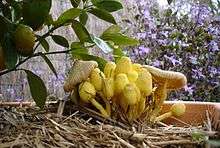
Though mushroom fruiting bodies are short-lived, the underlying mycelium can itself be long-lived and massive. A colony of Armillaria solidipes (formerly known as Armillaria ostoyae) in Malheur National Forest in the United States is estimated to be 2,400 years old, possibly older, and spans an estimated 2,200 acres (8.9 km2). Most of the fungus is underground and in decaying wood or dying tree roots in the form of white mycelia combined with black shoelace-like rhizomorphs that bridge colonized separated woody substrates.[15]
It has been suggested the electrical stimulus of a lightning bolt striking mycelia in logs accelerates the production of mushrooms.[16]
Nutrition
| Nutritional value per 100 g (3.5 oz) | |
|---|---|
| Energy | 94 kJ (22 kcal) |
|
4.3 g | |
|
0.1 g | |
|
2.5 g | |
| Vitamins | |
| Thiamine (B1) |
(9%) 0.1 mg |
| Riboflavin (B2) |
(42%) 0.5 mg |
| Niacin (B3) |
(25%) 3.8 mg |
| Pantothenic acid (B5) |
(30%) 1.5 mg |
| Vitamin B6 |
(8%) 0.11 mg |
| Folate (B9) |
(6%) 25 μg |
| Vitamin C |
(0%) 0 mg |
| Minerals | |
| Calcium |
(2%) 18 mg |
| Iron |
(3%) 0.4 mg |
| Magnesium |
(3%) 9 mg |
| Manganese |
(7%) 0.142 mg |
| Phosphorus |
(17%) 120 mg |
| Potassium |
(10%) 448 mg |
| Sodium |
(0%) 6 mg |
| Zinc |
(12%) 1.1 mg |
| Other constituents | |
| Selenium | 26 ug |
| Copper | 0.5 mg |
| |
|
Percentages are roughly approximated using US recommendations for adults. Source: USDA Nutrient Database | |
Raw brown mushrooms are 92% water, 4% carbohydrates, 2% protein and less than 1% fat. In a 100 gram (3.5 ounce) amount, raw mushrooms provide 22 calories and are a rich source (20% or more of the Daily Value, DV) of B vitamins, such as riboflavin, niacin and pantothenic acid, selenium (37% DV) and copper (25% DV), and a moderate source (10-19% DV) of phosphorus, zinc and potassium (table). Vitamin C and sodium have no or minimal content.
When exposed to ultraviolet (UV) light even after harvesting,[17] natural ergosterols in mushrooms produce vitamin D2,[18] a process now used to supply fresh vitamin D mushrooms for the functional food grocery market.[19]
In a comprehensive safety assessment of producing vitamin D in fresh mushrooms, researchers showed that artificial UV light technologies were equally effective for vitamin D production as in mushrooms exposed to natural sunlight, and that UV light has a long record of safe use for production of vitamin D in food.[19]
Human use

Edible mushrooms
Mushrooms are used extensively in cooking, in many cuisines (notably Chinese, Korean, European, and Japanese). Though neither meat nor vegetable, mushrooms are known as the "meat" of the vegetable world.[20]
Most mushrooms sold in supermarkets have been commercially grown on mushroom farms. The most popular of these, Agaricus bisporus, is considered safe for most people to eat because it is grown in controlled, sterilized environments. Several varieties of A. bisporus are grown commercially, including whites, crimini, and portobello. Other cultivated species available at many grocers include Hericium erinaceus, shiitake, maitake (hen-of-the-woods), Pleurotus, and enoki. In recent years, increasing affluence in developing countries has led to a considerable growth in interest in mushroom cultivation, which is now seen as a potentially important economic activity for small farmers.[21]
A number of species of mushrooms are poisonous; although some resemble certain edible species, consuming them could be fatal. Eating mushrooms gathered in the wild is risky and should only be undertaken by individuals knowledgeable in mushroom identification. Common best practice is for wild mushroom pickers to focus on collecting a small number of visually distinctive, edible mushroom species that cannot be easily confused with poisonous varieties. A. bisporus contains small amounts of hydrazines, the most abundant of which is agaritine.[22] However, the hydrazines are destroyed by moderate heat when cooking.[23]
More generally, and particularly with gilled mushrooms, separating edible from poisonous species requires meticulous attention to detail; there is no single trait by which all toxic mushrooms can be identified, nor one by which all edible mushrooms can be identified. Additionally, even edible mushrooms may produce allergic reactions in susceptible individuals, from a mild asthmatic response to severe anaphylactic shock.[24][25]
People who collect mushrooms for consumption are known as mycophagists,[26] and the act of collecting them for such is known as mushroom hunting, or simply "mushrooming".
China is a major edible mushroom producer. The country produces about half of all cultivated mushrooms, and around 2.7 kilograms (6.0 lb) of mushrooms are consumed per person per year by over a billion people.[27] In 2014, Poland was the world's largest mushroom exporter, reporting an estimated 194,000 tonnes annually.[28]
Toxic mushrooms

Many mushroom species produce secondary metabolites that can be toxic, mind-altering, antibiotic, antiviral, or bioluminescent. Although there are only a small number of deadly species, several others can cause particularly severe and unpleasant symptoms. Toxicity likely plays a role in protecting the function of the basidiocarp: the mycelium has expended considerable energy and protoplasmic material to develop a structure to efficiently distribute its spores. One defense against consumption and premature destruction is the evolution of chemicals that render the mushroom inedible, either causing the consumer to vomit the meal (see emetics), or to learn to avoid consumption altogether. In addition, due to the propensity of mushrooms to absorb heavy metals, including those that are radioactive, European mushrooms may, to date, include toxicity from the 1986 Chernobyl disaster and continue to be studied.[29][30]
Psychoactive mushrooms

Mushrooms with psychoactive properties have long played a role in various native medicine traditions in cultures all around the world. They have been used as sacrament in rituals aimed at mental and physical healing, and to facilitate visionary states. One such ritual is the velada ceremony. A practitioner of traditional mushroom use is the shaman or curandera (priest-healer).[31]
Psilocybin mushrooms possess psychedelic properties. Commonly known as "magic mushrooms" or "'shrooms", they are openly available in smart shops in many parts of the world, or on the black market in those countries that have outlawed their sale. Psilocybin mushrooms have been reported as facilitating profound and life-changing insights often described as mystical experiences. Recent scientific work has supported these claims, as well as the long-lasting effects of such induced spiritual experiences.[32]
Psilocybin, a naturally occurring chemical in certain psychedelic mushrooms such as Psilocybe cubensis, is being studied for its ability to help people suffering from psychological disorders, such as obsessive–compulsive disorder. Minute amounts have been reported to stop cluster and migraine headaches.[33] A double-blind study, done by the Johns Hopkins Hospital, showed psychedelic mushrooms could provide people an experience with substantial personal meaning and spiritual significance. In the study, one third of the subjects reported ingestion of psychedelic mushrooms was the single most spiritually significant event of their lives. Over two-thirds reported it among their five most meaningful and spiritually significant events. On the other hand, one-third of the subjects reported extreme anxiety. However, the anxiety went away after a short period of time.[34][35] Psilocybin mushrooms have also shown to be successful in treating addiction, specifically with alcohol and cigarettes.[36]
A few species in the Amanita genus, most recognizably A. muscaria, but also A. pantherina, among others, contain the psychoactive compound muscimol. The muscimol-containing chemotaxonomic group of Amanitas contains no amatoxins or phallotoxins, and as such are not hepatoxic, though if not properly cured will be non-lethally neurotoxic due to the presence of ibotenic acid. The Amanita intoxication is similar to Z-drugs in that it includes CNS depressant and sedative-hypnotic effects, but also dissociation and delirium in high doses.
Medicinal properties
Some mushrooms or extracts are used or studied as possible treatments for diseases, including polysaccharides, glycoproteins and proteoglycans.[37] Currently, several extracts have widespread use in Japan, Korea and China, as adjuncts to radiation treatments and chemotherapy,[38][39] even though clinical evidence of efficacy in humans has not been confirmed.
Historically, mushrooms have been thought to hold medicinal value in traditional Chinese medicine.[40] They have been studied in modern medical research since the 1960s, where most studies use extracts, rather than whole mushrooms.
In some countries, extracts of polysaccharide-K, schizophyllan, polysaccharide peptide, or lentinan are government-registered adjuvant cancer therapies.[38][41]
Other uses
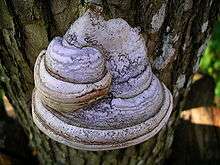
Mushrooms can be used for dyeing wool and other natural fibers. The chromophores of mushroom dyes are organic compounds and produce strong and vivid colors, and all colors of the spectrum can be achieved with mushroom dyes. Before the invention of synthetic dyes, mushrooms were the source of many textile dyes.[42]
Some fungi, types of polypores loosely called mushrooms, have been used as fire starters (known as tinder fungi).
Mushrooms and other fungi play a role in the development of new biological remediation techniques (e.g., using mycorrhizae to spur plant growth) and filtration technologies (e.g. using fungi to lower bacterial levels in contaminated water).[43]
See also
- Edible mushroom
- Fungiculture
- List of deadly fungi
- Lists of fungal species
- List of poisonous fungi
- List of psilocybin mushrooms
- List of world's largest mushrooms and conks
- Mushroom poisoning
- Psilocybin mushroom
References
- ↑ Dickinson C, Lucas J (1982). VNR Color Dictionary of Mushrooms. Van Nostrand Reinhold. pp. 9–11. ISBN 978-0-442-21998-7.
- ↑ Ammirati et al., 1985, pp. 40–41.
- ↑ Volk T. (2001). "Hypomyces lactifluorum, the lobster mushroom". Fungus of the Month. University of Wisconsin-La Crosse, Department of Biology. Retrieved 2008-10-13.
- ↑ Miles PG, Chang ST (2004). Mushrooms: Cultivation, Nutritional Value, Medicinal Effect, and Environmental Impact. Boca Raton, Florida: CRC Press. ISBN 0-8493-1043-1.
- ↑ Harding, Patrick (2008). Mushroom Miscellany. HarperCollins. p. 149. ISBN 978-0-00-728464-1.
- ↑ Ramsbottom J. (1954). Mushrooms & Toadstools: a study of the activities of fungi. London: Collins.
- ↑ Hay, William Deslisle (1887). "An Elementary Text-Book of British Fungi". London, S. Sonnenschein, Lowrey. pp. 6–7.
- ↑ Arora, David (1986). Mushrooms Demystified, A Comprehensive Guide to the Fleshy Fungi. Ten Speed Press. pp. 1–3. ISBN 978-0-89815-169-5.
- ↑ Hunter, Jessica. "The Mushroom Hunt". Synergy Magazine. Retrieved 2012-01-02.
- ↑ Stuntz et al., 1978, pp. 12–13.
- ↑ Stuntz et al., 1978, pp. 28–29.
- 1 2 3 Ammirati et al., 1985, pp. 25–34.
- ↑ Nelson N. (2006-08-13). "Parasola plicatilis". Retrieved 2008-10-13.
- ↑ Venturella, G. 2006. Pleurotus nebrodensis. In: IUCN. 2009. IUCN Red List of Threatened Species. Version 2009.1. http://www.iucnredlist.org/apps/redlist/details/full/61597/0 Downloaded on 15 October 2009.
- ↑ Dodge, S.R. "And the Humongous Fungus Race Continues". US Forest Service: Pacific Northwest Research Station. Retrieved 2011-02-28.
- ↑ "IEEE Xplore – Development of an Automatic Electrical Stimulator for Mushroom Sawdust Bottle". Ieeexplore.ieee.org. 2005-06-17. doi:10.1109/PPC.2005.300675. Retrieved 2014-01-24.
- ↑ Kalaras, M. D.; Beelman, R. B.; Elias, R. J. (2012). "Effects of postharvest pulsed UV light treatment of white button mushrooms (Agaricus bisporus) on vitamin D2 content and quality attributes". Journal of Agricultural and Food Chemistry. 60 (1): 220–5. doi:10.1021/jf203825e. PMID 22132934.
- ↑ Koyyalamudi SR, Jeong SC, Song CH, Cho KY, Pang G (2009). "Vitamin D2 formation and bioavailability from Agaricus bisporus button mushrooms treated with ultraviolet irradiation" (PDF). Journal of Agricultural and Food Chemistry. 57 (8): 3351–5. doi:10.1021/jf803908q. PMID 19281276.
- 1 2 Simon, R. R.; Borzelleca, J. F.; Deluca, H. F.; Weaver, C. M. (2013). "Safety assessment of the post-harvest treatment of button mushrooms (Agaricus bisporus) using ultraviolet light". Food and Chemical Toxicology. 56: 278–89. doi:10.1016/j.fct.2013.02.009. PMID 23485617.
- ↑ Haas EM, James P (2009). More Vegetables, Please!: Delicious Recipes for Eating Healthy Foods Each & Every Day. Oakland, California: New Harbinger Publications. p. 22. ISBN 978-1-57224-590-7.
- ↑ Making Money by growing Mushrooms
- ↑ Schulzova, V; Hajslova, J; Peroutka, R; Hlavasek, J; Gry, J; Andersson, H. C. (2009). "Agaritine content of 53 Agaricus species collected from nature". Food Additives & Contaminants: Part A. 26 (1): 82–93. doi:10.1080/02652030802039903. PMID 19680875.
- ↑ Siegered, AA, ed. (1998-01-01). "Spore Prints #338". Bulletin of the Puget Sound Mycological Society. Retrieved 2010-07-04.
- ↑ Hall et al., 2003, pp. 22–24.
- ↑ Ammirati et al., 1985, pp. 81–83.
- ↑ Metzler V, Metzler S (1992). Texas Mushrooms: a Field Guide. Austin, Texas: University of Texas Press. p. 37. ISBN 0-292-75125-7. Retrieved 2010-08-04.
- ↑ Hall et al., 2003, p. 25.
- ↑ "Poland: The world's largest mushroom exporter". Fresh Plaza. 8 April 2015. Retrieved 23 September 2016.
- ↑ "Belarus exports radioactive mushrooms, April 2008". Freshplaza.com. Retrieved 2014-01-24.
- ↑ Radioactivity levels in some wild edible mushroom species in Turkey by Seref Turhan et al. in Isotopes in Environmental and Health Studies, Volume 43, Issue 3 September 2007, pages 249–56
- ↑ Hudler GW. (2000). Magical Mushrooms, Mischievous Molds. Princeton, New Jersey: Princeton University Press. p. 175. ISBN 0-691-07016-4. Retrieved 2010-08-04.
- ↑ Griffiths R, Richards W, Johnson M, McCann U, Jesse R (2008). "Mystical-type experiences occasioned by psilocybin mediate the attribution of personal meaning and spiritual significance 14 months later". Journal of psychopharmacology (Oxford, England). 22 (6): 621–32. doi:10.1177/0269881108094300. PMC 3050654
 . PMID 18593735.
. PMID 18593735. - ↑ Sewell RA, Halpern JH, Pope HG (2006). "Response of cluster headache to psilocybin and LSD". Neurology. 66 (12): 1920–22. doi:10.1212/01.wnl.0000219761.05466.43. PMID 16801660.
- ↑ Griffiths RR, Richards WA, McCann U, Jesse R (2006). "Psilocybin can occasion mystical-type experiences having substantial and sustained personal meaning and spiritual significance". Psychopharmacology (Berl). 187 (3): 268–83. doi:10.1007/s00213-006-0457-5. PMID 16826400.
- ↑ Weil, A. (2006-10-16). "Looking for Mushroom Magic?". Retrieved 2010-08-04.
- ↑ "Clinical Sunday". maps.org.
- ↑ Borchers, A. T.; Krishnamurthy, A; Keen, C. L.; Meyers, F. J.; Gershwin, M. E. (2008). "The immunobiology of mushrooms". Experimental Biology and Medicine. 233 (3): 259–76. doi:10.3181/0708-MR-227. PMID 18296732.
- 1 2 "Mushrooms in cancer treatment". Cancer Research UK. 2013. Retrieved 25 June 2014.
- ↑ Borchers AT, Krishnamurthy A, Keen CL, Meyers FJ, Gershwin ME (2008). "The immunobiology of mushrooms". Experimental Biology and Medicine. 233 (3): 259–76. doi:10.3181/0708-MR-227. PMID 18296732.
- ↑ Khan, M. A.; Tania, M; Liu, R; Rahman, M. M. (2013). "Hericium erinaceus: An edible mushroom with medicinal values". Journal of Complementary and Integrative Medicine. 10. doi:10.1515/jcim-2013-0001. PMID 23735479.
- ↑ "Coriolus Versicolor". American Cancer Society. 1 November 2008. Retrieved 2011-03-01.
- ↑ Riika Raisanen (6 April 2009), "Dyes from lichens and mushrooms", in Thomas Bechtold and Rita Mussak, Handbook of Natural Colorants, John Wiley & Sons, pp. 183–200, ISBN 978-0-470-74496-3, retrieved 23 September 2016
- ↑ Kulshreshtha S, Mathur N, Bhatnagar P (2014). "Mushroom as a product and their role in mycoremediation". AMB Express. 4: 29. doi:10.1186/s13568-014-0029-8. PMC 4052754
 . PMID 24949264.
. PMID 24949264.
Literature cited
- Ammirati JF, Traquair JA, Horgen PA (1985). Poisonous Mushrooms of Canada: Including other Inedible Fungi. Markham, Ontario: Fitzhenry & Whiteside in cooperation with Agriculture Canada and the Canadian Government Publishing Centre, Supply and Services Canada. ISBN 0-88902-977-6.
- Hall IR, Stephenson SL, Buchanan PK, Yun W, Cole AL (2003). Edible and Poisonous Mushrooms of the World. Portland, Oregon: Timber Press. ISBN 0-88192-586-1.
- Stuntz DE, Largent DL, Thiers HD, Johnson DJ, Watling R (1978). How to Identify Mushrooms to Genus I. Eureka, California: Mad River Press. ISBN 0-916422-00-3.
External links
| Look up mushroom in Wiktionary, the free dictionary. |
 Media related to Mushrooms at Wikimedia Commons
Media related to Mushrooms at Wikimedia Commons Quotations related to Mushroom at Wikiquote
Quotations related to Mushroom at Wikiquote Mushroom at Wikibook Cookbooks
Mushroom at Wikibook Cookbooks "Mushroom". Encyclopædia Britannica. 19 (11th ed.). 1911.
"Mushroom". Encyclopædia Britannica. 19 (11th ed.). 1911.
Identification
- Mushroom Observer, a collaborative mushroom recording and identification project
- An Aid to Mushroom Identification, Simon's Rock College
- Online Edible Wild Mushroom Field Guide
